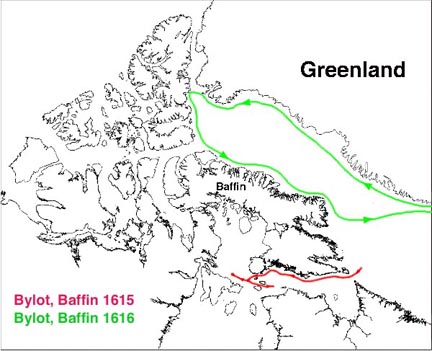

Information taken from Arctic Canada, Volume I, Third Edition, 1982
Long before the Europeans arrived, the Inuit were the first explorers of the Arctic. The Inuit have lived in the Arctic for thousands of years. Through their daily lives, they have travelled and explored the area in search of food, supplies and settlement areas. While most of their travels remain undocumented, the Inuit and other aboriginal groups are considered the first explorers of the "Northwest Passage" and many other northern areas.
Pytheas, a Greek, was the first explorer ever to describe the far north. In the late 300s B.C. he claimed to have sailed to an island in the north. At that time the Europeans believed everything in the north was covered by ice and it was not until the 1490s, when John Cabot proposed that there must exist a direct way to the Orient via the Northwest Passage, that the Europeans' interest in the far north was peaked.
It was during the 16th century that Europe began to investigate the possibility of a passage in the Northwest that would offer a safer sea route to the Orient than those which lay exposed to possible Spanish or Portuguese attack, such as the areas of Cape Horn and the Cape of Good Hope. This search was to continue for over 300 years, during which time explorers would brave the harsh climate and treacherous ice conditions of the North. Some men would lose their lives due to starvation, scurvy, attack by Inuit or even their fellow crew in an attempt to find a way through the maze of ice and islands.
While searching for the Northwest Passage, the Canadian Arctic began to take shape through the discoveries of new land and waterways by European explorers.
On their first voyage Baffin and Bylot charted the south coast of Baffin Island, gathering information on anchorages, tides and currents in the area. Bylot and Baffin believed they saw the coast, leading them to the conclusion that they had entered a great bay and decided to turn back. Baffin was convinced that the Northwest Passage could not be found in this direction and would lie up Davis Strait if it existed
In 1616 pilot William Baffin joined Robert Bylot, who was to act as Master, on an expedition which had been instructed to sail north along Greenland's west coast to the 80th parallel, then south and west to the 60th -thus reaching Japan. Not knowing, of course, that this was a physical impossibility (minor obstacles include Ellesmere Island and the permanent Arctic pack ice), they followed John Davis' route (1585-1587)and sailed Davis Strait as far north as 74°. Here they found a polynya, or pool of open water, at the head of Baffin Bay, which they dubbed the North Water. Still pushing northwards, following the coasts of Ellesmere, Devon and Bylot Islands they discovered Jones and Lancaster Sounds. 
Baffin was convinced that there was no passage north of Davis Strait and concluded that there was in fact no Northwest Passage. His conclusions regarding Davis Strait were accepted and it was not until two centuries later that the area would again attract interest.